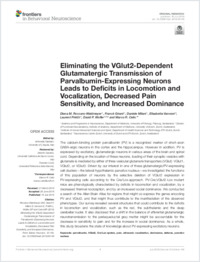Eliminating the VGlut2-dependent glutamatergic transmission of parvalbumin-expressing neurons leads to deficits in locomotion and vocalization, decreased pain sensitivity, and increased dominance
- Roccaro-Waldmeyer, Diana M. Anatomy and Programme in Neuroscience, Department of Medicine, University of Fribourg, Switzerland
- Girard, Franck Anatomy and Programme in Neuroscience, Department of Medicine, University of Fribourg, Switzerland
- Milani, Daniele Anatomy and Programme in Neuroscience, Department of Medicine, University of Fribourg, Switzerland
- Vannoni, Elisabetta Division of Functional Neuroanatomy, Institute of Anatomy, Department of Medicine, University of Zurich, Switzerland
- Prétôt, Laurent Anatomy and Programme in Neuroscience, Department of Medicine, University of Fribourg, Switzerland
- Wolfer, David P. Division of Functional Neuroanatomy, Institute of Anatomy, Department of Medicine, University of Zurich, Switzerland - Institute of Human Movement Sciences and Sport, Department of Health Sciences and Technology, ETH Zurich, Switzerland - Neuroscience Center Zurich, University of Zurich and ETH Zurich, Switzerland
- Celio, Marco R. Anatomy and Programme in Neuroscience, Department of Medicine, University of Fribourg, Switzerland
-
2018
Published in:
- Frontiers in Behavioral Neuroscience. - 2018, vol. 12, p. 146
English
The calcium-binding protein parvalbumin (PV) is a recognized marker of short-axon GABA-ergic neurons in the cortex and the hippocampus. However in addition, PV is expressed by excitatory, glutamatergic neurons in various areas of the brain and spinal cord. Depending on the location of these neurons, loading of their synaptic vesicles with glutamate is mediated by either of three vesicular glutamate transporters (VGlut): VGlut1, VGlut2 or VGlut3. Driven by our interest in one of these glutamatergic/PV-expressing cell clusters – the lateral hypothalamic parvafox nucleus - we investigated the functions of this population of neurons by the selective deletion of VGlut2 expression in PV-expressing cells according to the Cre/Lox-approach. PV- Cre;VGlut2-Lox mutant mice are phenotypically characterized by deficits in locomotion and vocalization, by a decreased thermal nociception, and by an increased social dominance. We conducted a search of the Allen Brain Atlas for regions that might co- express the genes encoding PV and VGlut2, and that might thus contribute to the manifestation of the observed phenotypes. Our survey revealed several structures that could contribute to the deficits in locomotion and vocalization, such as the red, the subthalamic and the deep cerebellar nuclei. It also disclosed that a shift in the balance of afferental glutamatergic neurotransmission to the periaqueductal grey matter might be accountable for the decrease in sensitivity to pain and for the increase in social dominance. As a whole, this study broadens the state of knowledge about PV- expressing excitatory neurons.
- Faculty
- Faculté des sciences et de médecine
- Department
- Département de Médecine
- Language
-
- English
- Classification
- Biological sciences
- License
- License undefined
- Identifiers
-
- RERO DOC 322924
- DOI 10.3389/fnbeh.2018.00146
- Persistent URL
- https://folia.unifr.ch/unifr/documents/307144
Other files
Statistics
Document views: 83
File downloads:
- cel_evd.pdf: 120
- cel_evd_sm.pdf: 116

